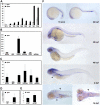Functional conservation of erythropoietin signaling in zebrafish
- PMID: 17579187
- PMCID: PMC1988930
- DOI: 10.1182/blood-2006-04-016535
Functional conservation of erythropoietin signaling in zebrafish
Abstract
Erythropoietin (Epo) and its cognate receptor (EpoR) are required for maintaining adequate levels of circulating erythrocytes during embryogenesis and adulthood. Here, we report the functional characterization of the zebrafish epo and epor genes. The expression of epo and epor was evaluated by quantitative reverse transcriptase-polymerase chain reaction (RT-PCR) and whole-mount in situ hybridization, revealing marked parallels between zebrafish and mammalian gene expression patterns. Examination of the hypochromic mutant, weissherbst, and adult hypoxia-treated hearts indicate that zebrafish epo expression is induced by anemia and hypoxia. Overexpression of epo mRNA resulted in severe polycythemia, characterized by a striking increase in the number of cells expressing scl, c-myb, gata1, ikaros, epor, and betae1-globin, suggesting that both the erythroid progenitor and mature erythrocyte compartments respond to epo. Morpholino-mediated knockdown of the epor caused a slight decrease in primitive and complete block of definitive erythropoiesis. Abrogation of STAT5 blocked the erythropoietic expansion by epo mRNA, consistent with a requirement for STAT5 in epo signaling. Together, the characterization of zebrafish epo and epor demonstrates the conservation of an ancient program that ensures proper red blood cell numbers during normal homeostasis and under hypoxic conditions.
Figures





References
-
- Williams D, Bunn HF, Sieff C, Zon LI. Hematopoiesis. In: Handin RI, Lux SE, Stossel TP, editors. Blood. 2nd ed. Philadelphia, PA: Lippincott Williams and Wilkins; 2003. pp. 147–208.
-
- Fisher JW. Erythropoietin: physiology and pharmacology update. Exp Biol Med (Maywood) 2003;228:1–14. - PubMed
-
- Richmond TD, Chohan M, Barber DL. Turning cells red: signal transduction mediated by erythropoietin. Trends Cell Biol. 2005;15:146–155. - PubMed
-
- Koury MJ, Bondurant MC. Erythropoietin retards DNA breakdown and prevents programmed death in erythroid progenitor cells. Science. 1990;248:378–381. - PubMed
Publication types
MeSH terms
Substances
Grants and funding
LinkOut - more resources
Full Text Sources
Molecular Biology Databases
Research Materials
Miscellaneous

